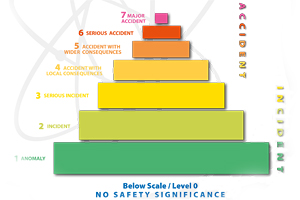The INES Scale
The International Nuclear and Radiological Event Scale (INES) is a tool for communicating to the
public the safety significance of nuclear and radiological events. The scale can be applied to
events occurring at diverse facilities (e.g., NPPs, fuel cycle facilities, research reactors
and accelerators and facilities associated with radioactive waste) and associated with a wide range
of activities. An assessment can also be performed, and a rating provided, for events during the
transport of radioactive materials and those involving the misplacement, loss, theft or detection
of radioactive sources or transport packages, such as, for example, the discovery of orphan
sources in scrap metal.
When a source is used in medicine (e.g. for medical or dental diagnosis or medical treatment), or in
veterinary medicine, only those events that result in the overexposure of workers and/or members of
the public or that entail a degradation of the defence in depth set up for the equipment can be rated.
Events involving actual or potential consequences for patients exposed to ionizing radiation as part
of a medical procedure are not covered by INES.
INES is used on a voluntary basis. Each Member State decides whether, when and how to communicate the
safety significance of an event, including the INES level.
The communication of events and of the respective INES levels does not constitute a formal reporting system.
INES is not intended to set requirements for reporting events to the regulatory authority or for
communicating them also to the public. It is not intended to be used for comparing the effectiveness of
the regulatory framework between different countries.
Similarly, it is not the purpose of INES to identify the facilities and activities that should be
included within the scope of the national regulatory control system. INES is not intended to be
used for comparison of the safety performance of operating organizations within a single country
or between different countries. The rating methodology evolved over the years, so the outcome of the
rating of certain past events might now be different if the latest methodology is applied.
Therefore, it is not recommended to apply the latest methodology retrospectively.
Additionally, comparison among countries could be misleading, because arrangements for communicating
events to the public may be different from country to country, and because not all countries apply
the full scope of INES.
The scale is not an emergency classification system, and it should not be used as a basis for
determining emergency response actions. Decisions on emergency response actions consider a wide range
of factors, such as the facility status, radiological situation, weather conditions, population
densities and evacuation capabilities. The INES methodology does not consider all of these factors
and, therefore, cannot form the basis for decisions on emergency response actions. Events are rated
on INES retrospectively, based on the consequences that happened or could have happened, not based
on the extent of the emergency response actions taken. Conversely, the emergency response actions
should not be used to automatically rate an event.
